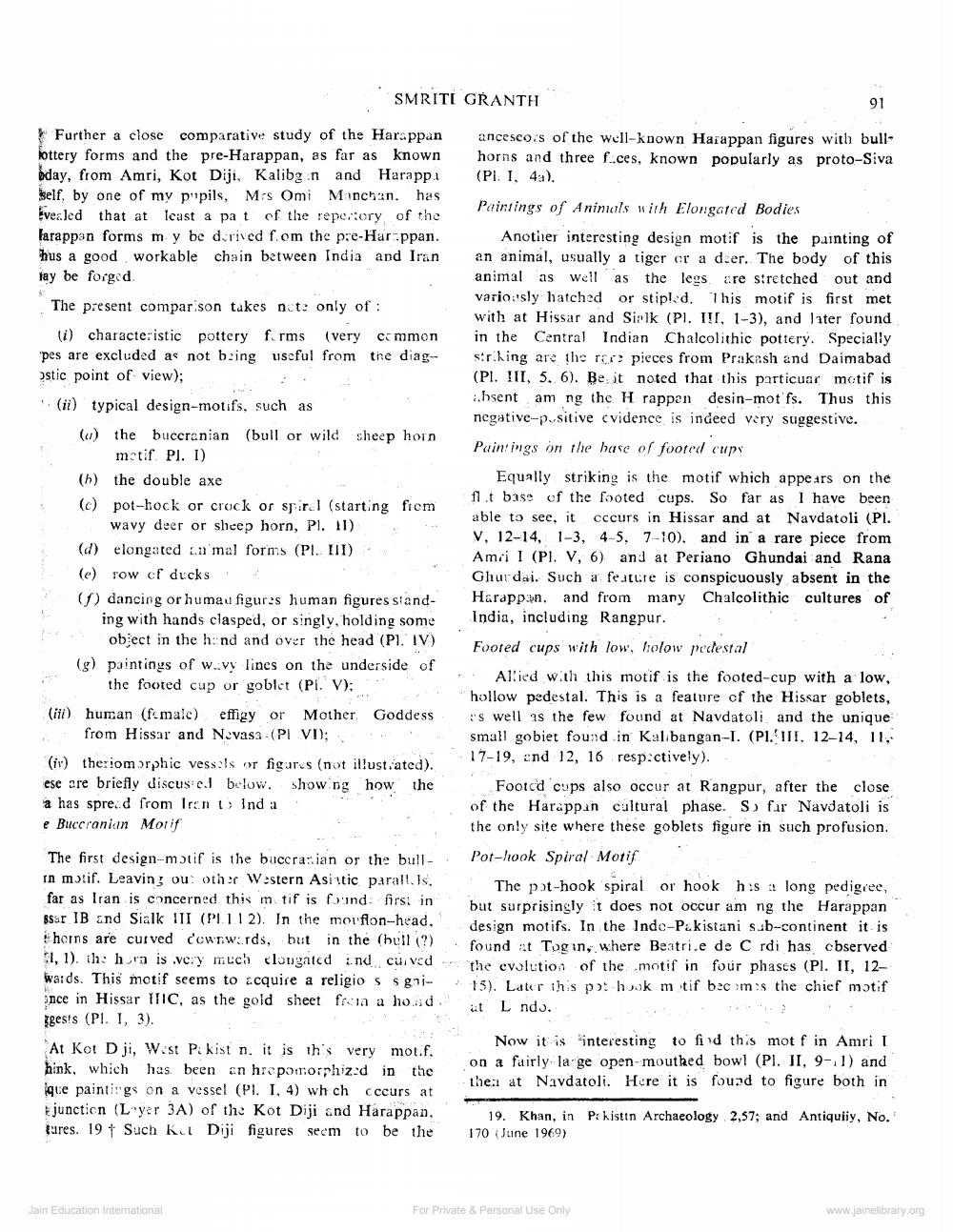________________
SMRITI GRANTH
Further a close comparative study of the Harappan ottery forms and the pre-Harappan, as far as known oday, from Amri, Kot Diji, Kalibgn and Harappa self, by one of my pupils, Mrs Omi Manchan. has vealed that at least a pa t of the repertory of the farappan forms my be derived f.om the pre-Harappan. hus a good workable chain between India and Iran jay be forged.
The present comparison takes not only of:
(i) characteristic pottery f.rms (very common pes are excluded as not being useful from the diagostic point of view);
(ii) typical design-motifs, such as
(a) the buccranian (bull or wild sheep horn motif. Pl. I)
(h) the double axe
(c) pot-hock or crock or spiral (starting frem wavy deer or sheep horn, Pl. 11)
(d) elongated animal forms (Pl. III) (e) row cf ducks
(f) dancing or humau figures human figures standing with hands clasped, or singly, holding some object in the hand and over the head (Pl. IV) (g) paintings of wavy lines on the underside of the footed cup or goblet (Pi. V);
(ii) human (female) effigy or Mother Goddess from Hissar and Nevasa (PI VI);
(iv) theriomorphic vessels or figures (not illustrated). ese are briefly discus el below, showing how the a has spread from Iran > Ind a
e Buccranian Motif
The first design-motif is the buccranian or the bullin motif. Leaving out other Western Asistic parall. Is, far as Iran is concerned this m. tif is found: first in ssar IB and Sialk III (PI.112). In the mouflon-head. horns are curved downwards, but in the (bell (?) 1, 1). the horn is very much elongated and curved wards. This motif seems to acquire a religio s s gaince in Hissar IIIC, as the gold sheet from a hod. ggests (Pl. I, 3).
At Kot D ji, West Pakist n. it is this very mot.f. hink, which has been an hropomorphized in the que paintings on a vessel (Pl. I, 4) wh ch cccurs at junction (Loyer 3A) of the Kot Diji and Harappan. tures. 19 Such K. Diji figures seem to be the
Jain Education International
91
ancesco:s of the well-known Harappan figures with bullhorns and three f.ces, known popularly as proto-Siva (Pl. I, 4a).
Paintings of Animals with Elongated Bodies
Another interesting design motif is the painting of an animal, usually a tiger or a deer. The body of this animal as well as the legs are stretched out and variously hatched or stipled. This motif is first met with at Hissar and Sialk (Pl. III, 1-3), and later found in the Central Indian Chalcolithic pottery. Specially striking are the rece pieces from Prakash and Daimabad (Pl. III, 5. 6). Be it noted that this particuar motif is .bsent am ng the H rappan desin-mot fs. Thus this negative-positive evidence is indeed very suggestive. Paintings on the base of footed cups
Equally striking is the motif which appears on the flt base of the footed cups. So far as I have been able to see, it cccurs in Hissar and at Navdatoli (Pl. V, 12-14, 1-3, 4-5, 7-10), and in a rare piece from Amri I (Pl. V, 6) and at Periano Ghundai and Rana Ghurdai. Such a feature is conspicuously absent in the Harappan, and from many Chalcolithic cultures of India, including Rangpur.
Footed cups with low, holow pedestal
Allied with this motif is the footed-cup with a low, hollow pedestal. This is a feature of the Hissar goblets, es well as the few found at Navdatoli and the unique small gobiet found in Kalibangan-I. (Pl. III, 12-14, 11, 17-19, and 12, 16 respectively).
Footed cups also occur at Rangpur, after the close of the Harappan cultural phase. So far Navdatoli is the only site where these goblets figure in such profusion. Pot-hook Spiral Motif
The pot-hook spiral or hook his a long pedigree, but surprisingly it does not occur am ng the Harappan design motifs. In the Indo-Pakistani sub-continent it is found at Togan, where Beatri.e de C rdi has observed the evolution of the motif in four phases (Pl. II, 1215). Later this pot-hook motif becomes the chief motif L ndл.
at
Now it is interesting to find this mot f in Amri I on a fairly large open-mouthed bowl (Pl. II, 9-1) and then at Navdatoli. Here it is found to figure both in
19. Khan, in Pakistin Archaeology 2,57; and Antiquiiy, No." 170 (June 1969)
For Private & Personal Use Only
www.jainelibrary.org




